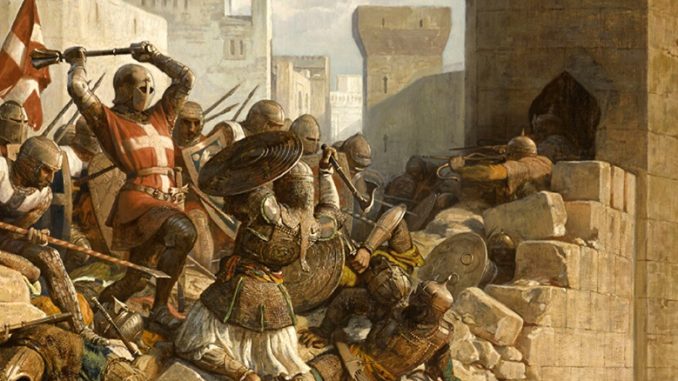
This article on Templar Battles in the East explores the victories and defeats of the Knights Templar throughout the Crusader era. It begins by examining some notable Templar victories, including the Battle of Ascalon in 1153, where they displayed their martial prowess and strategic skills. The article also discusses triumphs such as the Battle of Montgisard in 1177, the Battle of Acre in 1191, and the Battle of Arsuf in the same year, showcasing the Templars’ exceptional dedication and military acumen. However, the article also delves into the Templar defeats, such as the Battles of Damascus in 1129 and 1148, the Battles of Cresson Springs and Hattin in 1187, the Battle of La Forbie in 1244, and the Battles of Mansurah and Saphet in 1250 and 1291 respectively. These defeats underscore the challenges faced by the Templars and the Crusaders, highlighting the strength and resilience of their adversaries. The article aims to provide a comprehensive overview of the Templar victories and defeats throughout their crusading endeavors, shedding light on their impact on the broader Crusader history.
Templar Battles Victories
Templar Battles: 1153 Ascalon
The Templar Battle of 1153 in Ascalon was a significant event that unfolded during the Crusades. Ascalon, a strategic coastal city in the Kingdom of Jerusalem, was fiercely contested between the Crusader forces and the Egyptian Ayyubids. The Knights Templar, renowned for their martial prowess and unwavering commitment, played a pivotal role in this confrontation. In the scorching summer heat, the Templars demonstrated their military expertise, coordinating a relentless offensive against the Ayyubid defenders. Their disciplined formation and tactical superiority allowed them to breach the city’s walls, instilling fear in their adversaries. With swords raised and banners fluttering, the Templars engaged in fierce hand-to-hand combat, showcasing their unyielding resolve and unshakeable faith. The battle raged on for days, with both sides locked in a desperate struggle for victory. Ultimately, the Templars emerged triumphant, securing a hard-fought and decisive victory. Their success in the Battle of 1153 Ascalon bolstered the reputation of the Knights Templar and further solidified their place as a formidable force within the Crusader armies.
Templar Battles: 1177 Montgisard
The Battle of Montgisard in 1177 was a remarkable engagement where the Knights Templar, alongside the Crusaders, confronted the Ayyubid army led by Saladin. Despite being outnumbered, the Templars displayed unparalleled valor and strategic prowess, leading the charge against their foes. Their unwavering commitment and martial skills played a pivotal role in the Crusaders’ resounding victory, defying the odds and securing their place in history as formidable warriors.
Templar Battles: 1191 Acre
The Battle of Acre in 1191 was a momentous conflict during the Third Crusade. The Knights Templar, known for their unwavering resolve and military prowess, played a significant role in this siege. As part of the Crusader forces led by Richard the Lionheart, they fought valiantly against the formidable Ayyubid defenders under Saladin’s command. The Templars, distinguished by their white mantles adorned with the red cross, displayed exceptional discipline and strategic acumen. They fought alongside their fellow Crusaders, engaging in relentless assaults, withstanding the enemy’s fierce counterattacks, and demonstrating unmatched bravery. Despite the arduous and protracted nature of the siege, the Templars’ steadfastness and tactical expertise contributed to the eventual capture of Acre by the Crusaders, marking a crucial turning point in the Third Crusade. The Battle of Acre showcased the Templars’ indomitable spirit and solidified their reputation as elite warriors committed to the cause of the Crusades.
Templar Battles: 1191 Arsuf
The Battle of Arsuf in 1191 was a pivotal confrontation during the Third Crusade, where the Knights Templar played a crucial role. Led by Richard the Lionheart, the Crusader forces faced off against the Ayyubid army led by Saladin. In this battle, the Templars showcased their unwavering dedication and unmatched martial skills. Clad in their distinctive white mantles adorned with the red cross, they fought with relentless determination. With disciplined formations and strategic maneuvers, the Templars charged into battle, striking fear into the hearts of their enemies. Their unwavering discipline and unwavering faith were instrumental in repelling the fierce Ayyubid attacks and turning the tide of the battle. Through their valor and tactical acumen, the Templars, alongside the Crusaders, emerged victorious at Arsuf, securing a significant triumph in their quest to reclaim the Holy Land. The Battle of Arsuf stands as a testament to the Templars’ unwavering commitment and extraordinary prowess as formidable warriors during the Crusades.
Templar Battles: 1249 Damietta
The Battle of Damietta in 1249 marked a critical episode during the Seventh Crusade, and the Knights Templar played a significant role in the conflict. Damietta, a strategic Egyptian city, was fiercely contested between the Crusader forces and the Ayyubid defenders led by the Sultan, al-Malik al-Salih. The Templars, renowned for their martial prowess and unwavering dedication, fought at the forefront of the Crusader army. Clad in their distinctive white mantles adorned with the red cross, they led the charge with resolute determination. The Templars displayed exceptional discipline and tactical skill as they engaged in intense combat, employing their expert cavalry charges and precise formations. Their unwavering faith and indomitable spirit served as a driving force for the Crusaders, bolstering their resolve amidst the hardships of battle. Despite facing formidable opposition, the Templars fought with unmatched bravery, pushing forward to breach the city’s defenses. Their relentless determination and strategic acumen ultimately led to the capture of Damietta, securing a significant victory for the Crusaders. The Battle of Damietta showcased the Templars’ unwavering commitment and unwavering dedication to the Crusader cause, solidifying their reputation as an elite military order.
Defeats
Templar Battles: 1129 Damascus
The Templar defeat at Damascus in 1129 marked a significant setback during the Crusader era. Despite their renowned martial prowess and unwavering commitment, the Templars faced formidable challenges in their attempt to conquer the strategically important city. Damascus was defended by a combined force of Seljuk Turks and local Muslim defenders, who fiercely resisted the Crusader onslaught. The Templars, clad in their distinctive white mantles adorned with the red cross, fought valiantly at the forefront of the Crusader army. However, their relentless assaults and strategic maneuvers were met with fierce resistance, as the defenders utilized their knowledge of the terrain and the city’s fortifications to their advantage. Despite their unwavering faith and unwavering resolve, the Templars found themselves unable to overcome the formidable defenses and were forced to retreat. The defeat at Damascus served as a humbling reminder of the challenges faced by the Crusaders and the resilience of their adversaries. Nonetheless, the Templars would go on to learn valuable lessons from this defeat and continue their unwavering dedication to the Crusader cause in subsequent battles.
Templar Battles: 1139 Damascus
The Crusader defeat at Damascus in 1139 marked a significant setback in their efforts to maintain control over the Levant. The combined forces of the Crusader Kingdom of Jerusalem, including the Knights Templar, faced off against the formidable defenders of Damascus, led by their ruler, Fakhr al-Mulk ibn Ammar. Despite the Crusaders’ initial successes in breaching the city’s defenses, they soon found themselves overwhelmed by the resilient defenders and the unfavorable conditions. The defenders launched counterattacks with precision, exploiting the Crusaders’ vulnerabilities and gradually turning the tide of battle. The Crusaders, including the Templars, fought valiantly, but the superior military strategies and sheer determination of the defenders led to their defeat. The loss at Damascus served as a reminder of the challenges faced by the Crusaders and their need for careful planning and unity to succeed in their endeavors. It also demonstrated the resilience and capabilities of the Muslim forces defending their lands.
Templar Battles: 1148 Damascus
The Templar defeat at Damascus in 1148 marked a significant setback for the Knights Templar during the Second Crusade. The Templars, renowned for their military prowess and unyielding commitment, played a crucial role in the Crusader forces’ campaign to capture the strategically important city. However, despite their valiant efforts, they faced numerous challenges in their quest. The defenders of Damascus, led by the skilled military commander Imad ad-Din Zengi, skillfully utilized defensive tactics and effectively repelled the Crusader attacks. The Templars fought with unwavering determination, clad in their distinctive white mantles adorned with the red cross, but were ultimately unable to overcome the fortified defenses and the tactical prowess of their adversaries. The defeat at Damascus was a harsh blow to the Templars and the Crusader cause, highlighting the resilience and strategic capabilities of their opponents. It served as a reminder of the complexities and difficulties faced by the Crusaders in their attempts to gain control over the region.
Templar Battles: 1187 Cresson Springs
The Templar defeat at the Battle of Cresson Springs in 1187 was a devastating setback during the tumultuous period of the Crusades. Facing off against the forces of the Ayyubid Sultan Saladin, the Templars found themselves outnumbered and outmaneuvered. Despite their renowned martial prowess and unwavering commitment, the Templars were caught off guard and ill-prepared for the swift and determined attack launched by Saladin’s troops. The battle quickly turned into a chaotic and one-sided affair, with the Templars unable to effectively organize their defenses or mount a significant counteroffensive. Overwhelmed by Saladin’s superior forces, the Templars suffered heavy casualties and were ultimately defeated. The defeat at Cresson Springs was a sobering reminder of the challenges faced by the Crusaders in their attempts to maintain control in the Holy Land and the need for careful planning and coordination in their military operations.
The Templar defeat at the Battle of Hattin in 1187 was a pivotal moment during the Crusades, resulting in a devastating blow to the Crusader cause. Facing the forces of the Ayyubid Sultan Saladin, the Templars, along with other Crusader knights, found themselves engaged in a fierce struggle for control over the Holy Land. However, in the scorching heat of the summer, the Crusaders became trapped in a series of tactical errors that ultimately led to their downfall. Outmaneuvered and lacking sufficient supplies, the Templars fought valiantly but were unable to withstand Saladin’s strategic brilliance and the relentless assaults of his forces. The battle ended in a catastrophic defeat for the Crusaders, with many Templars falling in combat or being captured. The Templar defeat at Hattin marked a turning point in the Crusades, leading to the subsequent fall of Jerusalem and the decline of Crusader presence in the region. It stands as a tragic reminder of the perils faced by the Templars and the Crusaders in their quest to secure the Holy Land.
Templar Battles: 1187 Jerusalem – Surrender
The Templar surrender at Jerusalem in 1187 marked a profound moment of resilience and sacrifice during the Crusades. The city, besieged by the forces of the Ayyubid Sultan Saladin, found itself in a dire situation. The Templars, alongside other Crusader knights, defended the city with unwavering determination, but the relentless assaults and dwindling supplies ultimately took their toll. Faced with the imminent fall of Jerusalem, the Templars made the difficult decision to negotiate terms of surrender. In an act of valor, they secured the safety of the city’s Christian inhabitants, allowing them to leave unharmed. The Templars, recognizing the importance of protecting innocent lives, chose to sacrifice their control over the Holy City for the greater good. The surrender at Jerusalem served as a testament to the Templars’ unwavering commitment to their values and their willingness to make difficult choices in the face of overwhelming odds. Though the loss of Jerusalem was a tremendous blow, it also sparked renewed determination among the Crusaders to reclaim the city in the years to come.
Templar Battles: 1218 Damietta
The Siege of Damietta in 1218 proved to be a devastating defeat for the Crusaders, including the Knights Templar, during the Fifth Crusade. The Crusader forces, led by King John of Jerusalem and the papal legate Pelagius of Albano, sought to capture the strategically vital Egyptian city. However, the Crusaders faced numerous challenges during the prolonged siege. They were plagued by disease, supply shortages, and unfavorable weather conditions, which weakened their forces. The defending Ayyubid army, under the command of the brilliant Sultan al-Adil I, skillfully defended Damietta’s well-fortified walls. Despite the Templars’ renowned martial prowess and unwavering commitment, they were unable to overcome the formidable defenses and the determined resistance of the defenders. The Crusaders’ morale plummeted, and they were forced to retreat and ultimately surrender. The defeat at the Siege of Damietta dealt a severe blow to the Crusader cause, diminishing their chances of achieving their objectives in the Holy Land. It highlighted the challenges of waging distant military campaigns and the strength of the Ayyubid forces defending their homeland.
Templar Battles: 1244 La Forbie
The defeat at the Battle of La Forbie in 1244 was a significant setback for the Crusaders, including the Knights Templar, during the Sixth Crusade. The battle took place near Gaza, where the Crusader forces, led by Richard of Cornwall and Walter of Brienne, confronted the combined Ayyubid forces of Egypt and Syria. The Templars, renowned for their martial prowess, fought valiantly in the battle. However, they faced a formidable enemy led by the Ayyubid commander As-Salih Ayyub, who skillfully coordinated his forces in a devastating assault. The Crusaders found themselves outmaneuvered and overwhelmed by the overwhelming numbers and strategic acumen of the Ayyubid army. Despite the Templars’ fierce resistance, the battle resulted in a crushing defeat for the Crusaders. The loss at La Forbie had far-reaching consequences, as it not only weakened the Crusader presence in the region but also dealt a blow to their overall morale and objectives. It served as a stark reminder of the formidable challenges faced by the Crusaders and the strength of the Ayyubid forces defending their lands.
Templar Battles: 1250 Mansurah
The defeat at the Battle of Mansurah in 1250 marked a significant turning point for the Crusaders, including the Knights Templar, during the Seventh Crusade. The Crusaders, led by King Louis IX of France, sought to regain control over the Holy Land and embarked on an ambitious campaign to capture the Egyptian city of Mansurah. However, they found themselves facing a formidable opponent in the Ayyubid forces led by the capable commander, Sultan Turanshah. The Templars, renowned for their martial prowess, fought bravely alongside their fellow Crusaders. Despite their initial successes, the Crusaders became trapped in the city and found themselves besieged by the Ayyubid army. The defenders utilized their knowledge of the terrain and their superior numbers to launch devastating counterattacks, inflicting heavy casualties upon the Crusaders. The Templars fought with great valor, but they were ultimately overwhelmed. The defeat at Mansurah proved to be a devastating blow for the Crusaders, as it led to the capture of King Louis IX and a significant setback for their objectives in the Holy Land. The battle highlighted the challenges faced by the Crusaders and the resilience of their adversaries, underscoring the difficulty of sustaining a prolonged military campaign in unfamiliar territories.
Templar Battles: 1291 Saphet
The defeat at Saphet in 1291 marked a tragic conclusion to the Crusader presence in the Holy Land. As the Mamluk Sultanate relentlessly advanced upon the remaining Crusader strongholds, the Knights Templar found themselves defending the city of Saphet. Despite their legendary reputation and unwavering commitment, the Templars faced overwhelming odds against the Mamluk forces led by Sultan Al-Ashraf Khalil. The battle was fierce and protracted, with the Templars showcasing their martial prowess and tactical expertise. However, the Mamluks’ superior numbers, military strategies, and siege equipment eventually wore down the Crusader defenses. The fall of Saphet signaled the end of the Crusader era, as it was the last major stronghold under Templar control. The defeat was a devastating blow to the Templars and the remaining Crusaders, leading to their retreat and withdrawal from the Holy Land. The Battle of Saphet remains a somber reminder of the Crusaders’ ultimate defeat and the end of their aspirations to reclaim the Holy Land.
The defeat at Acre in 1291 marked a tragic end to the Crusader presence in the Holy Land. Acre, the last significant Crusader stronghold, faced a relentless siege by the Mamluk Sultanate forces under Sultan Al-Ashraf Khalil. The Knights Templar, alongside other Crusader orders, valiantly defended the city against overwhelming odds. However, despite their resilience and determination, the Crusaders found themselves outmatched by the superior numbers and military strategies of the Mamluks. The Mamluks utilized powerful siege engines, battering rams, and superior naval forces to breach the city’s defenses. The Templars fought fiercely but were ultimately overwhelmed by the relentless onslaught. The fall of Acre marked the end of an era, as it was the last major stronghold of the Crusaders in the Holy Land. The defeat at Acre resulted in the capture, imprisonment, or death of many Templars and effectively spelled the end of their presence in the region. The battle stands as a poignant reminder of the Crusaders’ ultimate failure to maintain control over the Holy Land and the resilience of their adversaries, the Mamluks.
About Us
TemplarHistory.com was started in the fall of 1997 by Stephen Dafoe, a Canadian author who has written several books on the Templars and related subjects.
Read more from our Templar History Archives – Templar History



